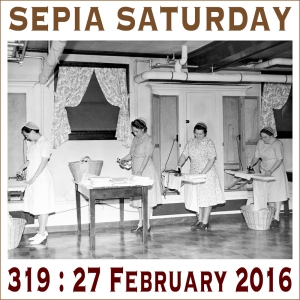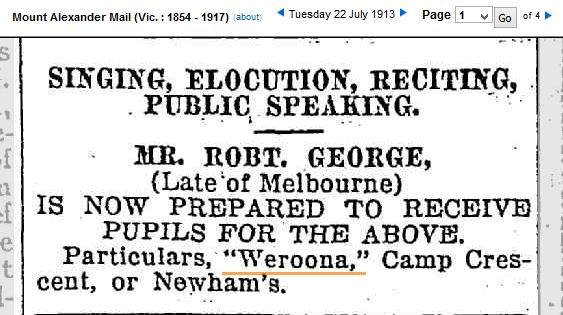I was given this poem written by W. Robertson many years ago as my great great grandfather, (Glaud) Pender is mentioned by name. The author wanders and reminisces about various early mine sites in Victoria, Australia. It was originally published as an eight page booklet. So far I haven’t found any more information or a source for it but no doubt there is someone out there who can tell us more.
THE OLD MINER
or
THE LAY OF THE LAST MINER
Whilst strolling through Con Burrow’s “Home”,
‘Mong lone ones who had ceased to roam,
The eye was caught of miner old,
Who yearned to tell of days of gold.
I bid good cheer, well filled the pipe,
And asked of his adventurous life.
He halved his seat with thankful smile,
And, in response, in digger’s style,
Told of his life in district mines
From early to the latest times.
I noted how his eyes grew bright
In spite of age and locks snow-white;
While proud he held his head erect
As if he had naught to regret,
He started with a pleasure keen, –
A last rally, as will be seen;
He’d pondered oft those stirring times,
In Fifty-one, when but a lad,
At “Hiscock’s”, I remember dad
Excited got on finding gold,
And gave up care of shepherd’s fold;
He took me when from there he went
Up further north on golden scent.
We pitched our camp, hence Ballarat
Where gold was got from hill and flat.
They were the days when life was fast –
Mates came from shop, farm, bank and mast,
Chancing nuggets or a duffer:
Some made their piles – some but tucker.
He rushed “Canadian”, also “Eureka”,
And “Black Hill” did the gold seeker,
A rope, pick, dish, with windlass short,
Cradle and tub came as from naught.
Shanked it from ship did chums galore,
Sure on landing of fortunes store.
Good finds first were on shallow ground,
And following, each lead deeper down
To wet and drift on “Gum Tree Flat”,
We found all leads did steer for that.
The “Baker Hill” from “Oval” came,
At Humffray Street went west again;
It gave a nugget at the rise, –
“The “Wecome” – famous for its size.
“Gravel Pits” lead from “Loco” shed
Was traced down past the Fire Brigade,
Then on across the “Main” “Plank” road,
Where southern streams gave it their load.
This “Road” which was our favourite walk
Would history tell if it could talk.
Here with crinoline and flounces
The ladies came to share our ounces;
From then was firm foundation laid,
Of that which we’ve a city made.
We’ve ebbed and flowed, oft been in doubt –
I recall “The East” when luck was out,
Croakers arose – rock was ahead.
Still better north ! so rumour said:
Bendigo news gave gold fever.
I rolled my swag for the walk over;
Worked there a while, then Castlemaine,
When news from West moved me again;
Now on a coach – no more a walker –
Mates booked my seat on to Majorca.
Then my habit – craving for change –
Brought me to “Back Creek” o’er the range;
Easy won wash, good gold was got;
This place is now known as Talbot.
“Cobb” took us then on to Avoca;
Too quiet for me. – thanks for your smoke, sir;
Your weed is good. Oh! you’re a gent –
Your coin will be carefully spent.
From Avoca to Ararat,
To “Canton Lead”, “Flint” and “Cathcart,”
I journeyed as a digger bold
Who knew all tricks that could be told.
The miners’ life, in their own way,
I lived and lived but for the day;
While luck was in I spent too free,
And thus I oft was “on the spree”.
To “Fiery Creek” I went full tear,
When tidings came of a rush there;
Beaufort was rich, and Raglan too;
We opened Chute, then Waterloo.
‘Twas overrun. When Linton shone
I joined again the moving throng
To gullies rich and flats that feed
The “Edinburgh” and “Standard Lead”.
“Lucky Woman’s” gave all a thrill
When gold was struck on “Dreamer’s Hill”.
Times were good – we did not dally,
But worked from there to Happy Valley,
In deeper runs my mates then went,
Below basalt, sand, and cement.
We had “Morey”, a “Canterbrey,”
“Volunteers” with the “Waverley,”
But “British” miners beat the lot,
And made this place a noted spot.
We traced the lead down past the “Cleft”,
To Piggoreet right o’er a clift,
Where met we with the Smythe’s creek men,
‘Tween “Trunk” and “Horn” at “Try Again.”
Here was the “Devil’s Kitchen” famed –
Old-timers thought ‘twould ne’er be tamed;
But times do change – they tell me now
“There’s not enough to make a row.
Past “Golden”, “Belts”, “Gates,” “Streams,” and “Lakes,”
Where Pender, Webb, and Maughan were mates,
Through Newtown, up the Scarsdale run,
I worked my passage to Haddon,
And saw that township at its prime,
When no one drew the colour line,
While I was on my country tour,
Ballarat mates made good and sure;
Well paid for all their work they got
By tracing lead west under rock,
Through Curtis Street to Lydiard’s crest,
‘Cross Sturt and Dana, then south-west.
The “Frontage Scheme”, here they did try it –
It caused as much talk as “The Riot”.
In legal fees, it thousands cost,
Thus profits were to miners lost.
We since have found “The Block” was best –
A system that has stood the test.
Over western quartz the dirt was rich,
Here mining reached its highest pitch.
Who forgets the “Koh-i-noor” and “Band”?
The “Albion” or the “Hand in Hand”?
The “Inkerman”? – it gave great wealth,
But scoured a valley for itself.
From Newington it went out west,
Where in the Park, we’ll let it rest.
The main lead to the “Milkmaid” ran,
Past “Malakoff,” out to “Redan”,
‘Twas hurrah! for “St. George” and “Red Jacket”,
As through Sebas, they then did track it,
Right to the edge of “Plateau’s” rails,
Where “Cobblers” fed the “Prince of Wales”,
Past “Bonshaw” on to “Alstan’s” height,
Where Watson ruled with “Gulf” in sight.
There the “Scottish and the Cornish”
On Cambrian Hill lived with the Welsh;
Over a channel was Napoleon.
Which turned the lot east to the Durham;
From here the gold was thin and fine,
But where was crossed the “Eastern Line”;
Though Buninyong gave in its share,
The Durham sluices showed but fair.
Revival came to Creswick again;
“Australasians” call was “More Men!”
I heard, and left the “Chinese” town,
Scarce lost a shift – just there and down.
The lead got poor; you know, I wot,
Of disaster – that’s not forgot!
Awful! Awful! Depressed we were,
While “Spring Hill” continued like a flare,
Inviting all; all roads led there;
Miners re-met from everywhere.
Its shallow runs they gave good divs.
How money flowed in memory lives;
Still deeper down it kept its glory,
Through “De Murska” to “Ristori”.
Here Peacock, Brawn, and Leishman start –
I mean, of course, their mining part.
In Allendale I made my home,
Worked in the “Madame” and the “Lone”;
The crib-time of our life was here,
Where all were gay and of good cheer.
‘Twas “out of date” to have a tent;
The carpet bags to tip were sent;
Red shirts had gone, and moleskins vile;
Sac suits to order were the style.
We sorry were to leave this home
Again alluvial fields to roam.
Quartz ? Not me! I enjoyed too true
The alluvial life and mates I knew;
No quartz for me, with dusty slopes!
The graveyard of digger’s hopes !
I had a turn at Rutherglen,
But lonely felt among new men.
Soon I was back to Carisbrook
To “Chalks”, “Pioneer”, then o’er to “Duke,”
And “Main Lead’s” mines, where Bryant says
The champions were of mining days.
Timor now waned, Alma had gone,
Craigie no more had “Napes” or “Kong”.
“Mt Mercer” then gave forth a call,
But proved the poorest of them all.
The Rokewood spurt – not worth a fig –
A shallow, sandy place to dig.
At Pitfield we had novel times,
The summer sun roasts as it shines;
Its bleak and windy clayey plains
Are churned to mud by winter’s rains;
But spite of that a lively run,
In huts and shanties there was fun;
The field was poor, and was my last;
Other diggings have gone down fast.
I, wage-earning, left, worked in the creek,
Till age warned me to give up the seek;
From then till now I’ve taken rest,
And followed mining from the press.
The “Mt William” rush was like a meteor –
A flash, then over, was its feature;
Rutherglen’s wound up, Creswick the same,
In Ballarat it lacks a name;
No money for Avoca’s “Stream”;
Tom Mitchell’s tried to “Ristor”(e),I read,
The fortunes of the Kingston lead;
The “Langi” field has been a dud,
“Cept where enriched by Cathcart’s flood;
They’ve failed the “Durham” to revive,
It seems we’ve lost the power to strive.
There’s miles of leads, both deep and wet,
Which for the future will be left.
We’ve enjoyed our pleasures to the dregs,
And put Australia on its legs,
Less fickle goods with gold does change;
Hence, no spurts in “Corner” or “Exchange”.
Ah! thus it seems the end is near
Of life and times I held so dear.
Good luck! to those who canny were,
And now enjoy their own armchair.
But, as for me, I’ve had my day,
I’m feeling faint – ’tis Nature’s way;
Evening’s near gone – give me your hand,
I feel that I no more will stand.
Remember me to miners all;
Tell them I’m paying my last call;
I fancy now two whistles blow –
That means but a short time to go.
Darkness comes on; night shift draws nigh;
The air is bad . . . good-bye . . . good-b —.
W. ROBERTSON Ballarat East.
What made me remember this poem was an interesting series of posts in the Carisbrook Historical Facebook Group about the belt buckles the men used to wear and which people find in these old mining areas. The ornamentation on the buckles highlights the diversity of people who followed the gold diggings.
Put belt buckles into the Search Box and you will get a ovely selection of photos and comments.
https://www.facebook.com/groups/1436750269909379/
The following Cricket belt buckle was found in the ruins of an old miners hut near Castlemaine, with many Chinese coins beside it. You can find the full details about it here.






 March 14th 1951
March 14th 1951





